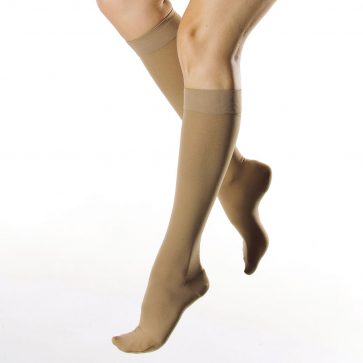Peripheral Oedema – A Guide
What is peripheral oedema? This condition simply describes excess fluid that can build up in our legs, arms and hands. For most people, ankle swelling is the uncomfortable result.
Our simple guide to peripheral oedema – also known as lymphoedema will tell you everything you want to know about the causes of peripheral oedema. We also provide advice on peripheral oedema treatment, including how wearing compression hosiery is a great way to reduce ankle swelling.
For Peripheral Oedema, Daylong recommends:
What is Peripheral Oedema?
Peripheral oedema is the medical term for the build-up of excess fluid in our legs and ankles, or in our arms and hands. This can often lead to swelling, especially in our ankles. A good test for the condition is to press your finger into your skin around a swollen ankle and to see if it remains depressed rather than springing back. As well as swelling in your ankles and feet, other symptoms of peripheral oedema include:- You get tired, heavy and aching legs, particularly after standing for a long time
- The colour of your skin changes, most often looking darker
- You can experience stiffness in your knee or ankle joints
- You may gain weight, which is due to excess fluid
- Your blood pressure can increase
How to prevent Peripheral Oedema
It’s important that you talk to your GP to get a diagnosis of the condition that is leading to your peripheral oedema. You may be prescribed diuretics to reduce fluid retention. Your doctor will also be able to advise you on a few simple measures that can also help with the symptoms of peripheral oedema. For example, you may:- Exercise to improve your circulation
- Lose weight if you need to
- Rest with your ankles higher than your hip to encourage fluid out of your lower legs
- Wear support stockings, support tights or a compression sleeve for your arm
What causes Peripheral Oedema?
Many people suffer peripheral oedema when the weather is very hot. Others get peripheral oedema when they stand or sit for long periods. There are also a number of medical conditions which can also lead to peripheral oedema. These include:- Heart problems: When your heart becomes less efficient, fluid retention is common.
- Pregnancy: Many women find that their ankles and feet swell towards the end of pregnancy.
- Kidney problems: The kidney controls fluid balance within the body and kidney disease can make this less efficient.
- Liver disease: Excess fluid in the tissues is often an outcome of liver disease.
- Drug treatments: Steroids, some types of high blood pressure tablets and the contraceptive pill can result in peripheral oedema.
- Issues with leg veins: These include varicose veins and deep vein thrombosis.
- Cancer treatment: Surgery to remove lymph nodes can result in lymphoedema.
Top tips to prevent Peripheral Oedema
If you experience ankle swelling you should see your doctor to find out what the underlying problem is. Following these peripheral oedema treatment tips – including wearing compression hosiery – can help you avoid problems.- Maintain any medication you have been prescribed by your doctor if you have an underlying problem.
- Get expert advice from a dietician if you have been advised to change your diet or lose weight.
- Buy made-to-measure compression support stockings to help reduce the impact of ankle swelling.
- Follow an exercise programme recommended by your doctor.

